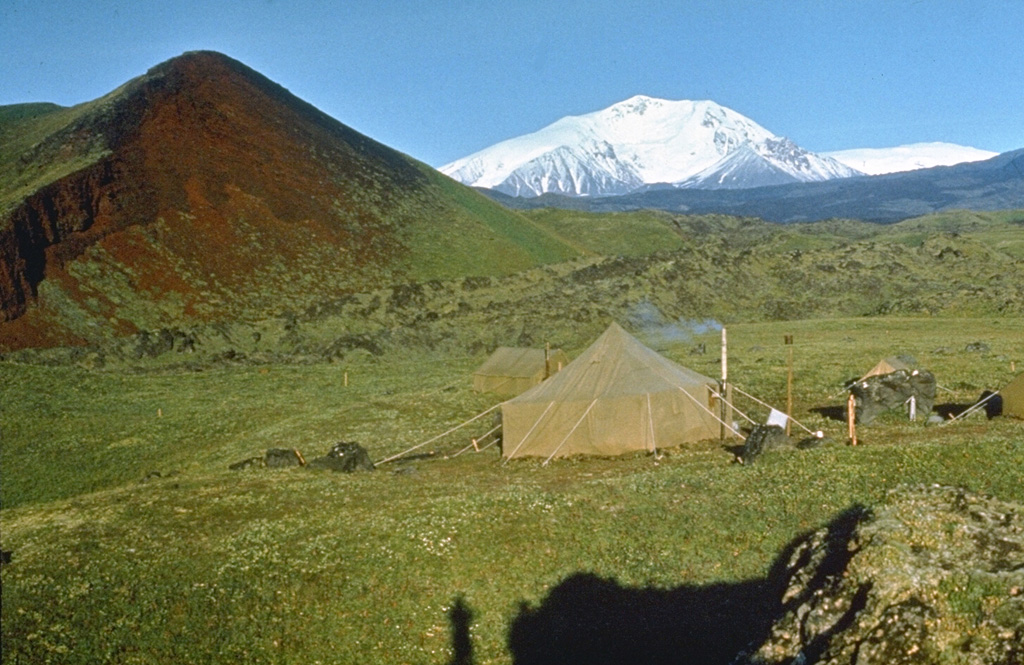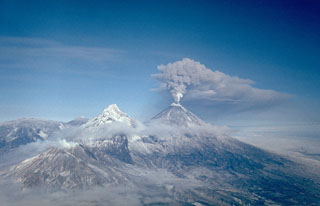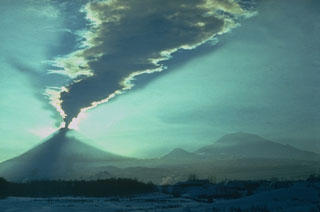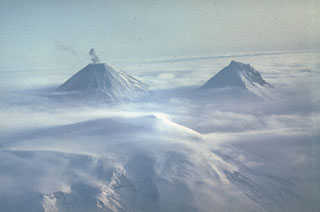

Earthquakes form distinctive group
On the basis of waveform features and locations, earthquakes in the vicinity of the volcano during November were identified as constituting a separate group. Since September 1998 more than 20 events with magnitudes ranging from 0.5 to 1.0 occurred at shallow depths (<5 km).
Information Contacts: Olga Chubarova, Kamchatka Volcanic Eruptions Response Team (KVERT), Institute of Volcanic Geology and Geochemistry, Piip Ave. 9, Petropavlovsk-Kamchatsky, 683006, Russia; Tom Miller, Alaska Volcano Observatory (AVO), a cooperative program of a) U.S. Geological Survey, 4200 University Drive, Anchorage, AK 99508-4667, USA (URL: http://www.avo.alaska.edu/), b) Geophysical Institute, University of Alaska, PO Box 757320, Fairbanks, AK 99775-7320, USA, and c) Alaska Division of Geological & Geophysical Surveys, 794 University Ave., Suite 200, Fairbanks, AK 99709, USA.
The Global Volcanism Program has no Weekly Reports available for Ushkovsky.
Reports are organized chronologically and indexed below by Month/Year (Publication Volume:Number), and include a one-line summary. Click on the index link or scroll down to read the reports.
Glacier surge
The volcano's 17-km-long Bilchenok Glacier has begun to advance. The glacier, located in Plosky's caldera, has three large ice cascades on its NW flank. Previous surges of this glacier occurred in 1959, 1976, and 1977. Photo reconaissance flights over Kamchatkan glaciers 10-11 March revealed that Bilchenok's front was 1 km from its 1980 position and 500 m from the 1959 maximum surge. Its surface was broken into blocks, and rupture disturbances of the snow cover were observed.
Further Reference. Ovsyannikov, A.A., Khrenov, A.P., and Murav'yeva, Y.D., 1985, Recent activity of the Dal'nya Ploskaya volcano: Volcanology and Seismology, no. 5, p. 97-98.
Information Contacts: V. Vinogradov, IVP.
Earthquakes form distinctive group
On the basis of waveform features and locations, earthquakes in the vicinity of the volcano during November were identified as constituting a separate group. Since September 1998 more than 20 events with magnitudes ranging from 0.5 to 1.0 occurred at shallow depths (<5 km).
Information Contacts: Olga Chubarova, Kamchatka Volcanic Eruptions Response Team (KVERT), Institute of Volcanic Geology and Geochemistry, Piip Ave. 9, Petropavlovsk-Kamchatsky, 683006, Russia; Tom Miller, Alaska Volcano Observatory (AVO), a cooperative program of a) U.S. Geological Survey, 4200 University Drive, Anchorage, AK 99508-4667, USA (URL: http://www.avo.alaska.edu/), b) Geophysical Institute, University of Alaska, PO Box 757320, Fairbanks, AK 99775-7320, USA, and c) Alaska Division of Geological & Geophysical Surveys, 794 University Ave., Suite 200, Fairbanks, AK 99709, USA.
This compilation of synonyms and subsidiary features may not be comprehensive. Features are organized into four major categories: Cones, Craters, Domes, and Thermal Features. Synonyms of features appear indented below the primary name. In some cases additional feature type, elevation, or location details are provided.
Synonyms |
||||
| Plosky | Ploskaya | Ushkinskaya | Uskovskii | Ploskye Sopki | Ushkovskaya | Ploski | ||||
Cones |
||||
| Feature Name | Feature Type | Elevation | Latitude | Longitude |
|
Daljny Plosky
Dalnyaya Plosky Bolshaya Plosky Dal'nii Plosky |
Shield volcano | 3943 m | 56° 4' 13" N | 160° 28' 12" E |
| Gorshkov | Cone | |||
| Herz | Cone | |||
|
Krestovsky
Blizhny Ploski Blizhnaya Ploskaya Krestovskaya Krestovskii Malaya Ploskaya |
Stratovolcano | 4039 m | 56° 6' 48" N | 160° 30' 32" E |
|
Lavovy Shish
Lavovy Shysh |
Cone | |||
|
Sredny
Srednyaya |
Stratovolcano | 2989 m | 56° 6' 35" N | 160° 34' 48" E |
|
|
||||||||||||||||||||||||||
There is data available for 3 confirmed Holocene eruptive periods.
1890 Apr Confirmed Eruption VEI: 2 (?)
| Episode 1 | Eruption | |||||||||||||||||||||||||
|---|---|---|---|---|---|---|---|---|---|---|---|---|---|---|---|---|---|---|---|---|---|---|---|---|---|
| 1890 Apr - Unknown | Evidence from Observations: Reported | ||||||||||||||||||||||||
|
List of 3 Events for Episode 1
| |||||||||||||||||||||||||
6670 BCE ± 150 years Confirmed Eruption
| Episode 1 | Eruption | Lavovy Shish cone group & summit caldera | |||||||||||||||||||
|---|---|---|---|---|---|---|---|---|---|---|---|---|---|---|---|---|---|---|---|---|
| 6670 BCE ± 150 years - Unknown | Evidence from Isotopic: 14C (uncalibrated) | |||||||||||||||||||
|
List of 2 Events for Episode 1 at Lavovy Shish cone group & summit caldera
| ||||||||||||||||||||
7550 BCE (?) Confirmed Eruption
| Episode 1 | Eruption | ||||||||||||||||||||
|---|---|---|---|---|---|---|---|---|---|---|---|---|---|---|---|---|---|---|---|---|
| 7550 BCE (?) - Unknown | Evidence from Isotopic: 14C (uncalibrated) | |||||||||||||||||||
|
List of 2 Events for Episode 1
| ||||||||||||||||||||
There is no Deformation History data available for Ushkovsky.
There is no Emissions History data available for Ushkovsky.
 This photo looks north along the cluster of large edifices forming the Klyuchevskaya volcano group. Udina (foreground) and Zimina (middle right) are Holocene cones. Kamen (top center) and Klyuchevskoy (top right) are the far-background. Ushkovsky volcano (top left) lies at the NW end of the volcanic group. Bezymianny is hidden below clouds beside Kamen.
This photo looks north along the cluster of large edifices forming the Klyuchevskaya volcano group. Udina (foreground) and Zimina (middle right) are Holocene cones. Kamen (top center) and Klyuchevskoy (top right) are the far-background. Ushkovsky volcano (top left) lies at the NW end of the volcanic group. Bezymianny is hidden below clouds beside Kamen.  Four volcanoes of the Klyuchevskaya volcano group are visible in this north-looking view. A gas plume emanates from the summit of Bezymianny in the foreground, which is dwarfed by Kamen behind it. Klyuchevskoy is to the upper right, and Ushkovsky is on the left horizon. Krestovsky forms the rounded summit and the glacier-covered Ushkovsky caldera is visible to the far-left.
Four volcanoes of the Klyuchevskaya volcano group are visible in this north-looking view. A gas plume emanates from the summit of Bezymianny in the foreground, which is dwarfed by Kamen behind it. Klyuchevskoy is to the upper right, and Ushkovsky is on the left horizon. Krestovsky forms the rounded summit and the glacier-covered Ushkovsky caldera is visible to the far-left. An ash plume erupts from the summit of Klyuchevskoy on 16 February 1987. Long-term activity includes both explosive and effusive activity from summit and flank vents. This view from the south shows Bezymianny producing a small plume at the lower left, Kamen at the left center, and the broader Ushkovsky on the left horizon.
An ash plume erupts from the summit of Klyuchevskoy on 16 February 1987. Long-term activity includes both explosive and effusive activity from summit and flank vents. This view from the south shows Bezymianny producing a small plume at the lower left, Kamen at the left center, and the broader Ushkovsky on the left horizon. An ash plume from Klyuchevskoy in 1979 is dispersed in front of the sun in this view looking from the SW. This was part of a dominantly explosive eruption that took place from August 1977 until 1980. The eruption concluded with explosive activity and lava effusion from a flank vent during 5-12 March 1980. Ushkovsky is to the right, with the small Sredny cone in the center.
An ash plume from Klyuchevskoy in 1979 is dispersed in front of the sun in this view looking from the SW. This was part of a dominantly explosive eruption that took place from August 1977 until 1980. The eruption concluded with explosive activity and lava effusion from a flank vent during 5-12 March 1980. Ushkovsky is to the right, with the small Sredny cone in the center. Clouds drape the margins of the glacier-covered summit caldera of Ushkovsky (Plosky) volcano in the foreground. Two of the highest volcanoes in Kamchatka, Klyuchevskoy (left) and Kamen (right) rise above the layer of clouds to the SE. A small ash plume drifts above the summit of Klyuchevskoy, one of Kamchatka's most active volcanoes.
Clouds drape the margins of the glacier-covered summit caldera of Ushkovsky (Plosky) volcano in the foreground. Two of the highest volcanoes in Kamchatka, Klyuchevskoy (left) and Kamen (right) rise above the layer of clouds to the SE. A small ash plume drifts above the summit of Klyuchevskoy, one of Kamchatka's most active volcanoes.  Ushkovsky is a large compound volcanic massif located at the NW end of the Klyuchevskaya volcano group. Seen here from the NW, it consists of the flat-topped Ushkovsky (far right), which is capped by an ice-filled 4.5 x 5.5 km caldera, and the adjacent higher Krestovsky peak (center). Numerous scoria cones have formed on its flanks.
Ushkovsky is a large compound volcanic massif located at the NW end of the Klyuchevskaya volcano group. Seen here from the NW, it consists of the flat-topped Ushkovsky (far right), which is capped by an ice-filled 4.5 x 5.5 km caldera, and the adjacent higher Krestovsky peak (center). Numerous scoria cones have formed on its flanks.  Kamen (left), Klyuchevskoy (right), and the broad snow-capped Ushkovsky behind them to the west, form the northern end of the Klyuchevskaya volcano group. Ushkovsky consists of the flat-topped Ushkovsky volcano on the left, which is capped by an ice-filled 4.5 x 5.5 km caldera, and the adjacent slightly higher Krestovsky peak on the right.
Kamen (left), Klyuchevskoy (right), and the broad snow-capped Ushkovsky behind them to the west, form the northern end of the Klyuchevskaya volcano group. Ushkovsky consists of the flat-topped Ushkovsky volcano on the left, which is capped by an ice-filled 4.5 x 5.5 km caldera, and the adjacent slightly higher Krestovsky peak on the right.  Symmetrical Klyuchevskoy and the eroded Ushkovsky edifice are seen here SW of the town of Klyuchi. The small Sredny cone, constructed on the eastern flank of Ushkovsky, occupies the saddle between them. Klyuchevskoy is one of Kamchatka's most active volcanoes and Ushkovsky has also erupted in historical time.
Symmetrical Klyuchevskoy and the eroded Ushkovsky edifice are seen here SW of the town of Klyuchi. The small Sredny cone, constructed on the eastern flank of Ushkovsky, occupies the saddle between them. Klyuchevskoy is one of Kamchatka's most active volcanoes and Ushkovsky has also erupted in historical time.Maps are not currently available due to technical issues.
There are no samples for Ushkovsky in the Smithsonian's NMNH Department of Mineral Sciences Rock and Ore collection.
| Copernicus Browser | The Copernicus Browser replaced the Sentinel Hub Playground browser in 2023, to provide access to Earth observation archives from the Copernicus Data Space Ecosystem, the main distribution platform for data from the EU Copernicus missions. |
| MIROVA | Middle InfraRed Observation of Volcanic Activity (MIROVA) is a near real time volcanic hot-spot detection system based on the analysis of MODIS (Moderate Resolution Imaging Spectroradiometer) data. In particular, MIROVA uses the Middle InfraRed Radiation (MIR), measured over target volcanoes, in order to detect, locate and measure the heat radiation sourced from volcanic activity. |
| MODVOLC Thermal Alerts | Using infrared satellite Moderate Resolution Imaging Spectroradiometer (MODIS) data, scientists at the Hawai'i Institute of Geophysics and Planetology, University of Hawai'i, developed an automated system called MODVOLC to map thermal hot-spots in near real time. For each MODIS image, the algorithm automatically scans each 1 km pixel within it to check for high-temperature hot-spots. When one is found the date, time, location, and intensity are recorded. MODIS looks at every square km of the Earth every 48 hours, once during the day and once during the night, and the presence of two MODIS sensors in space allows at least four hot-spot observations every two days. Each day updated global maps are compiled to display the locations of all hot spots detected in the previous 24 hours. There is a drop-down list with volcano names which allow users to 'zoom-in' and examine the distribution of hot-spots at a variety of spatial scales. |
|
WOVOdat
Single Volcano View Temporal Evolution of Unrest Side by Side Volcanoes |
WOVOdat is a database of volcanic unrest; instrumentally and visually recorded changes in seismicity, ground deformation, gas emission, and other parameters from their normal baselines. It is sponsored by the World Organization of Volcano Observatories (WOVO) and presently hosted at the Earth Observatory of Singapore.
GVMID Data on Volcano Monitoring Infrastructure The Global Volcano Monitoring Infrastructure Database GVMID, is aimed at documenting and improving capabilities of volcano monitoring from the ground and space. GVMID should provide a snapshot and baseline view of the techniques and instrumentation that are in place at various volcanoes, which can be use by volcano observatories as reference to setup new monitoring system or improving networks at a specific volcano. These data will allow identification of what monitoring gaps exist, which can be then targeted by remote sensing infrastructure and future instrument deployments. |
| Volcanic Hazard Maps | The IAVCEI Commission on Volcanic Hazards and Risk has a Volcanic Hazard Maps database designed to serve as a resource for hazard mappers (or other interested parties) to explore how common issues in hazard map development have been addressed at different volcanoes, in different countries, for different hazards, and for different intended audiences. In addition to the comprehensive, searchable Volcanic Hazard Maps Database, this website contains information about diversity of volcanic hazard maps, illustrated using examples from the database. This site is for educational purposes related to volcanic hazard maps. Hazard maps found on this website should not be used for emergency purposes. For the most recent, official hazard map for a particular volcano, please seek out the proper institutional authorities on the matter. |
| IRIS seismic stations/networks | Incorporated Research Institutions for Seismology (IRIS) Data Services map showing the location of seismic stations from all available networks (permanent or temporary) within a radius of 0.18° (about 20 km at mid-latitudes) from the given location of Ushkovsky. Users can customize a variety of filters and options in the left panel. Note that if there are no stations are known the map will default to show the entire world with a "No data matched request" error notice. |
| UNAVCO GPS/GNSS stations | Geodetic Data Services map from UNAVCO showing the location of GPS/GNSS stations from all available networks (permanent or temporary) within a radius of 20 km from the given location of Ushkovsky. Users can customize the data search based on station or network names, location, and time window. Requires Adobe Flash Player. |
| DECADE Data | The DECADE portal, still in the developmental stage, serves as an example of the proposed interoperability between The Smithsonian Institution's Global Volcanism Program, the Mapping Gas Emissions (MaGa) Database, and the EarthChem Geochemical Portal. The Deep Earth Carbon Degassing (DECADE) initiative seeks to use new and established technologies to determine accurate global fluxes of volcanic CO2 to the atmosphere, but installing CO2 monitoring networks on 20 of the world's 150 most actively degassing volcanoes. The group uses related laboratory-based studies (direct gas sampling and analysis, melt inclusions) to provide new data for direct degassing of deep earth carbon to the atmosphere. |
| Large Eruptions of Ushkovsky | Information about large Quaternary eruptions (VEI >= 4) is cataloged in the Large Magnitude Explosive Volcanic Eruptions (LaMEVE) database of the Volcano Global Risk Identification and Analysis Project (VOGRIPA). |
| EarthChem | EarthChem develops and maintains databases, software, and services that support the preservation, discovery, access and analysis of geochemical data, and facilitate their integration with the broad array of other available earth science parameters. EarthChem is operated by a joint team of disciplinary scientists, data scientists, data managers and information technology developers who are part of the NSF-funded data facility Integrated Earth Data Applications (IEDA). IEDA is a collaborative effort of EarthChem and the Marine Geoscience Data System (MGDS). |